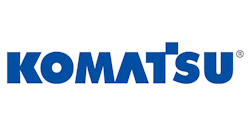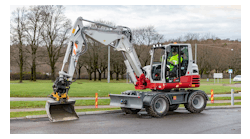Form follows function when it comes to attachments. As hydraulic excavators have evolved, replacing the cable shovels of yesterday, sophisticated, groundbreaking buckets have followed suit. Whether you need a digging implement for soft soil, which requires short, blunt teeth, or something that’s going to penetrate through rock and frost that will require pointed, longer teeth, the key component is getting the right equipment on the site. Knowing the range of functions in attachments is critical. What is the machine’s intended role? Is it backfilling, trenching, or clearing? What is the composition and density of the soil? What is the bucket’s design specification in terms of weight and power?
There’s an enormous variance of buckets even when it comes to widths. A narrow bucket concentrates its penetrating forces along a shorter edge and is good in hard ground. Rocket cutting buckets are shaped to create a bonnet to reduce drag and increase efficiency. Hardpan or frost buckets are designed much like the rock bucket, but with additional ripper teeth, and teeth welded to the back to loosen compacted soil. Cleanup buckets are similar to the scoop attachment minus the teeth, and have a straight, large edge best used for sloping, leveling, and backfilling. The other major category type would be the skeleton bucket, which would allow an operator to separate coarser material from finer, based on tooth width.
Stephane Giroudon is a general manager at Geith North America. He says Geith’s main users of attachments are contractors that use the heavy-duty equipment severe duty buckets for general construction site work, as well as for more demanding excavation applications involving abrasive or compact material, such as rock gravel and clay. Many customers need a deep profile for leveling and loading applications, and Geith offers up to “90 degrees of rotation from side to side, enabling contractors to complete routing tasks, such as slope finishing, land clearing, and grading with a greater ease.”
Such products are good but the customers also are looking for unique features such as heavy-duty bottom wear straps and high side plates. These features help safeguard their buckets against harmful wear patterns. Also, says Giroudon, “optional internal wear straps and additional wear shrouds, or side-cutters, provide increased strength and wear protection.” Giroudon also made the point that contractors are looking for “buckets with a dual radius shape that increase heel clearance.” They reduce drag and wear. “Customers want buckets that feature a deep profile for high capacity, and ones that have a low tip radius for greater digging leverage.”
Contractors, from general construction to more specialized landscaping and utility applications, are always looking for tools to help them do their jobs more efficiently. Speed and ease can translate into greater profitability. Using a piece of construction equipment with different attachments can revolutionize a construction professional’s business, enabling them to bid on larger projects and to work in all weather and ground conditions. By carefully selecting the right attachments, customers can maximize their profits—and attachments can end up paying for themselves.
Versatility is most often the name of the game when it comes to attachments. Cathy DeSanto is the Operations Manager for Alpine Equipment. She explains that their Rockwheel rock and concrete grinders are used by a wide variety of contractors from smaller owner operators to large international tunneling firms. “And since the applications for this attachment vary so widely, the types of contractors also vary quite a bit—from underground limestone mines to concrete rehab companies to utility trench contractors and even soil stabilization outfits,” says DeSanto. She adds that the primary applications are concrete scaling, trenching, mining/tunneling, and soil mixing.
A number of Alpine’s customers buy more than just one attachment. Some of their larger quarry and mining customers buy multiple units to increase production. And according to DeSanto, “a contractor that buys a larger Rockwheel, for example, might see that having a smaller one on hand for a smaller excavator in their fleet would also be beneficial.”
Alpine Equipment knows their customers want good production rates and a good value. “The Rockwheel can offer precision cutting and reduced need for backfill in trenching operations, so value can come in more ways than just the higher production rates,” says DeSanto.
Jonathan Ferguson from Terex Construction Americas says it simply: “Most contractors already have one or more tool carriers in their fleet.” This could be anything from compact utility loaders, skid-steer loaders, compact track loaders, and wheel loaders, to backhoe loaders or telehandlers. “These multi-use loaders can provide a significant savings to any contractor’s business by eliminating the need for various dedicated specialty machines.” He pointed out that when equipped with a universal quick-attach system, loaders offer versatility and ease of use, and, because attachments can be changed out relatively quickly—often times by simply turning two locking pins and connecting hydraulic lines—using a loader as a multipurpose landscaping tool enhances productivity and efficiency.
Buckets, augers, trenchers, vibratory plows, breakers, backhoes, levelers, tillers, cultivators, forks, blades, brush hogs or saws, land planes, and rakes are the attachments most commonly associated with landscaping projects. And by adding rotary brooms and snow blowers to a contractor’s fleet, a seasonal business is able to easily expand, offering service on a year-round basis.
“Manufacturers, such as Terex, offer a variety of attachment options for the compact lines of [their] construction equipment to increase the versatility and utilization of these machines,” says Ferguson. “We’ve had customers say that their attachments will basically pay for themselves in one season with the number of jobs they bring in. Then they’ll have that piece of equipment forever, and will continue to profit from it with the additional jobs. For customers who were watching their bottom lines in the down construction economy, attachments are cheaper than buying a new machine. It allows them to be more job-specific, while at the same time giving them more options with their current equipment.”
Attachments for production work need to have both durability and power for repeat applications, and they need to match the loader’s horsepower and hydraulic capabilities.
“It is a good idea to source your attachments through the distributorship where you purchased your equipment,” says Ferguson. “Your distributor knows the machine’s exact hydraulic specifications and will counsel you on which attachments will work with your unit. It is important to let your distributor know all of the potential applications you want to perform, because this will influence what advice your distributor gives to you when making a machine purchase.”
Ferguson adds that “contractors are always looking for ways to increase revenue with their current machinery inventories. Attachments are the best way to keep overhead in line for owners and operators.” Attachments can turn one machine into a multipurpose tool. New attachments are coming along every day, and contractors should be on the lookout for new products that make their job more efficient. Adding attachments to perform profitable tasks is always a good financial decision, simply because they cost relatively little compared to the revenue stream they can see as a result of performing more tasks on the job site. For this reason he says, “One way savvy business owners can better manage their fleet inventories versus cost of equipment acquisition is to think outside of the box when it comes to equipment offerings and utilization.”
One fundamental consideration when it comes to purchasing is that attachments need to be durable and reliable because downtime is expensive. According to Ferguson, “Another important factor is that the attachment is going to be adequate for 85–90% of the job site’s needs. Also a consideration for contractors is to make sure the attachment is the right size for the machine on which it will be used. The key to productivity is to make sure the machine’s hydraulic flow matches the attachment, and that it is easy for operators to change out and operate the attachment. For instance, quick coupler systems make it fast and easy to change attachments and auxiliary hydraulics offer flexibility in adding attachments.”
A key component to a profitable bottom line is equipment utilization. Wouldn’t it behoove contractors to invest in a multipurpose tool? In one scenario, such a compact track loader with a dozer blade attachment could handle dozing applications, as well as other tasks. With efficiency and profits in mind, how much more utilization could be achieved per unit? How would that increase profitability? Dedicated equipment is optimal for a fleet of machines if the contractor’s main business requires the use of that equipment the majority of the time. But what if a contractor does more general construction type of work and needs equipment with more versatility? Some dedicated pieces of equipment can run as high as $150,000 per unit, and this must be weighed against the machine utilization rate. Ideally, a contractor wants a unit that moves the same amount of material in a short period of time, but is also able to take on other applications by simply switching out an attachment, such as taking off a dozer blade and putting a bucket or mulcher on the unit, to increase utilization rates. It’s not always possible for a dedicated machine to do this.
Customers demand attachments that maximize productivity. According to Matt Franzel, product manager at Atlas Copco Construction Equipment, they have developed attachments that minimize downtime, enhance ease of use, and generate powerful outputs. For example, Atlas Copco’s Pro line and Essential line breakers feature box-style mounting systems, which eliminate the need for removing external fasteners to access components, such as wear bushings and seals. This contributes to expedited turnaround times for maintenance, and as a result, greater uptime. Heavy Range Atlas Copco breakers feature nitrogen-gas assist, in which nitrogen gas works with the hydraulic oil to accelerate the piston. This reduces hydraulic oil demand from the carrier’s hydraulic systems and delivers consistently high-impact energy.
“We design our equipment to withstand harsh work sites, including construction yards, because durability contributes to maximum uptime,” says Franzel. He also noted that Atlas Copco’s complete spectrum of attachments is made with industrial-grade components, and minimal moving parts, “which contributes to long service lives and low servicing downtime.” Carrier versatility is also key to maximizing productivity. Hydraulic attachments allow carrier owners to complete a wide range of tasks with one machine instead of relying on multiple pieces of equipment. It takes considerably less time and money to switch out an attachment than to utilize another piece of equipment to complete a task.
Demolition contractors are the main users of his attachments because of the variety of attachments available and the versatility they offer. Their equipment team—an operator and spotter—often use just one carrier to complete a wide range of tasks, from demolishing and excavating, to material sorting and truck loading.
Franzel adds that waste management companies also use attachments to break, sort, and recycle concrete from demolition sites. These companies don’t have the luxury of space to work at the demolition site, so certain waste management companies will pick up the materials to process later at its facility. Once at a recycling facility, operators break down the rubble using a breaker or pulverizer, and use a grapple or magnet attachment to sort steel rebar.
There also are general contractors and utility crews that might not use attachments during day-to-day tasks, but will rent them to enhance productivity on larger or more challenging jobs. Some rental centers carry multiple attachments, including breakers, grapples, and pulverizers in their equipment fleet so they can offer a wide range of solutions to customers.
“Demolition contractors purchase multiple attachments to maximize their carrier’s versatility for demolition and sorting applications.” For example, a carrier operator might use a breaker or Combi Cutter to demolish a concrete surface; a grapple to sort the debris; a pulverizer to separate steel from concrete rubble; a hydraulic magnet to pull out recyclable, ferrous metal; and a bucket crusher to process material on site. Aggregate quarries might also use a breaker attachment, to reduce large boulders and rocks into smaller, more manageable debris. This materialmight get transported to a secondary crusher to reduce it further to meet their customers’ specifications.
It’s common for rental centers to carry many of the same attachments because they have high utilization rates.
“A rental center might purchase multiples of Atlas Copco’s Pro Line or Essential Line breakers, for example. The breakers fit a wide range of carrier weight classes—from 3 to 140 tons—and are simple to handle and maintain due to their streamlined bodies,” says Franzel. This ensures rental customers will have a hydraulic breaker that fits almost any carrier. This also allows rental centers to achieve high utilization because their mechanics can service the attachments easily before the next customer. When it comes to servicing demolition companies, rental centers might also purchase other hydraulic attachments, including grapples, hydraulic magnets, and pulverizers, to offer a range of solutions for customers in recycling applications.
Franzel says that their attachments are used primarily on excavators, “but they also fit different carriers, including remote-controlled demolition machines, skid-steer loaders, and stationary booms.” Atlas Copco offers several attachment sizes so they can be used effectively and safely with a wide range of carrier sizes, from 3-ton to 140-ton weight classes.
Since there is an abundance of tool carrier options and models available, an attachment will work differently depending on the machine. For example, continuous-flow attachments require equipment designed with higher auxiliary hydraulic flow or dedicated auxiliary hydraulic circuits. Without this design option, certain continuous-flow attachments would need to be run on larger units, in order to work effectively. The larger units, however, may not work well on space-restricted job sites and can increase operating costs by increasing fuel and maintenance costs. Since some attachments are designed for smaller, more compact machines, they may not fit well on larger units.
Again, Jonathan Ferguson from Terex also pointed out that “you never want to exceed the rated operating capacity, or flow capacities of the tool carrier.” Overloading the operating capacity or hydraulic rates can cause the unit to tip forward or cause hydraulic components to fail. Another consideration to ensure safe operation of your attachment is to be aware of existing infrastructure, obstacles, and people in the vicinity of a working attachment. Spinning attachments, like mulchers, brush cutters, brooms, or cold planers, will discharge materials as they work. These attachments can eject job-site debris up to several feet away from the unit, which could cause potential harm to people and damage to property in the area.
Other considerations when trying to increase efficiency and utilization times are the innovations made in the engineering of couplers. Design innovations now give the contractor the flexibility to make quick attachment changes on hydraulic excavators. As a result, changing from an excavating bucket to a finishing bucket to something even smaller like a grapple or hammer now only takes a matter of minutes. New designs of quick coupler models represent some of the most significant improvements when it comes to connection speed and ease of operation. Somecontractors can change attachments over 50 times a day.
Jessica Howisey from Helac Corp. says, “With the ease of changing attachments from the cab, the hydraulic coupler can save an operator considerable machine operating time compared to a manual mount. The operator has the ability to reverse buckets to shovel mode at any time to excavate against walls, under pipes, and in other terrains.” She notes that their new PowerTilt tilting coupler is just a latest innovation that has a variable pin center, which is designed to accommodate a wide range of original equipment manufacturer attachments. Helac has equipped them with a number of safety features such as front safety locks that retain the attachments in case of a misconnection and a “curl to release” control system, which guarantees the attachment only releases in a safe position. Howisey also mentioned that the industry is trending towardshydraulic couplers, especially in Europe, because they are “faster, easier, and safer to use.”
Philip Paull, owner of Excavating Solutions, designs attachments, couplers, and automation products that he invents and patents. He explains that his “whole mission is to make products that involve less labor, increase speed, and are safe to use.” He’s been involved in more than 23,000 excavating jobs over the last 20 years. He designs and manufactures buckets and dig systems. He has obtained 10 patents and has an additional 13 patents pending. He says that he dreamed of having the products he uses today, even claiming that “his mission in life” had been to reduce costs because “insurance and labor costs are out of sight.” He says anything that helps eliminate grading people, or reduces over-cutting or reworking, will only add value to your business and move the needle toward cost savings. He says that he builds and experiments, describing himself as an out-of-the-box engineer who exercises every day in the running of his business so he can stay competitive. “Most of my products are sold individually to people, but many are sold to dealers such as RDO Equipment Co., Position Solutions, Brandt, other big Topcon dealers—also Trimble and many more.”
Bill Pankracij from Indeco North America says that some of the trends he sees are products that “increase utilization of tools such as multi-functional to maximize excavator efficiencies,” as well as “telematics and M2M capabilities on excavators to wirelessly monitor project information.” Indeco provides attachments to the construction, demolition, aggregate, mining, and scrap industries. Rental organizations, large footprint contractors who service the utility and natural gas industries, large quarries, and aggregate producers tend to buy more than one product. Pankracij adds that some of the most important features needed to remain competitive are “attachments that leverage and are consistent with the enhanced programmability of today’s and future excavators.”
Job diversification has become increasingly critical to contractors looking to keep their business competitive. The ability to easily change out a variety of attachments can help contractors grow their business and increase profitability. Whether or not a contractor decides to buy or rent, the key feature seems to be a product that provides high utilization rates, ease of use, and durability.










